Women, life, freedom: The chants of Iran’s protests
Protests grow in Iran after the death of a young woman who was detained by the country’s morality police.
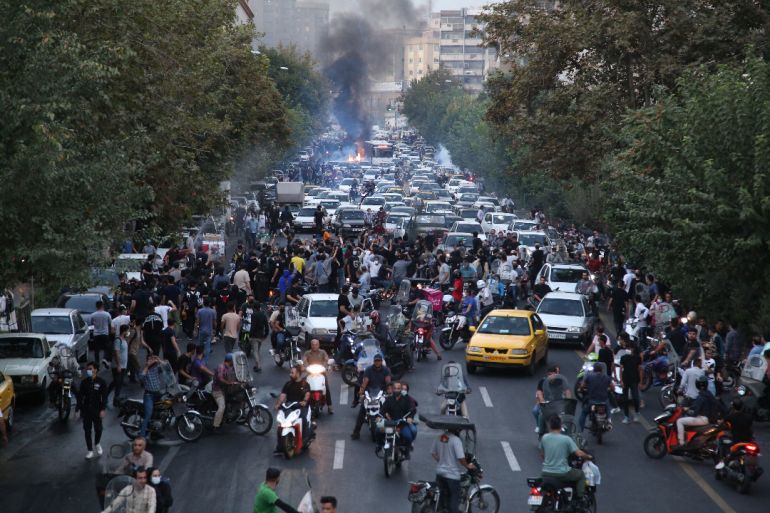
For nearly two weeks now, protests in Iran have been gaining momentum. The spark was the death of Mahsa Amini, also known as Jina, a young Kurdish woman who died after being detained by Iran’s morality police for “improper hijab”. But the fuel for the demonstrations is something many women across Iran have been feeling for decades. Today, a look into the protests rocking the country.
Keep reading
list of 4 itemsIs Italy returning to its Fascist past?
How are Black American farmers reclaiming their land?
What’s ailing Bollywood’s string of flops?
In this episode:
- Dorsa Jabbari (@DorsaJabbari), Al Jazeera correspondent
Connect with us:
@AJEPodcasts on Twitter, Instagram, and Facebook
Full episode transcript:
This transcript was created using AI. It’s been reviewed by humans, but it might contain errors. Please let us know if you have any corrections or questions. Our email is TheTake@aljazeera.net.
[WOMEN CHANTING]
Halla Mohieddeen: For nearly two weeks now, protests in Iran have been gaining momentum.
Newsreel: Daily uprisings, mostly led by women, have been taking place for more than a week.
Halla Mohieddeen: The spark was the death of a young woman who had been detained by the country’s morality police.
Newsreel: Police say she was arrested for dressing improperly. She collapsed in custody and died several days later in hospital.
Halla Mohieddeen: But what’s fuelled the protests is something many women across the country have been feeling for decades.
Dorsa Jabbari: We all felt like we could be Mahsa. Any one of us women in that country. Every time we leave the house, we have the fear of being stopped by the morality police, and not knowing what will happen to us afterwards.
Halla Mohieddeen: I’m Halla Mohieddeen, and this is The Take.
[THEME MUSIC PLAYING]
Halla Mohieddeen: Today I’m speaking with Al Jazeera’s Dorsa Jabbari. Dorsa was in Iran recently on a reporting trip, covering nuclear deal negotiations. Towards the end of her stay, though, a different story began to spread.
Halla Mohieddeen: So Dorsa, when did you first come across the name Mahsa Amini. What do we know about her life?
Dorsa Jabbari: The first time I heard of Mahsa Amini was on Friday, the day that she was pronounced dead in the afternoon. In the morning, there was a post from Academy Award-winning director Asghar Farhadi on his Instagram page showing a picture of her, on a hospital bed, in a coma. And he had explained her story. And that’s the first time I heard of her.
Halla Mohieddeen: That was Friday, September 16. And the story of Mahsa, also known by her Kurdish name, Jina, was beginning to make its way around the Iranian internet.
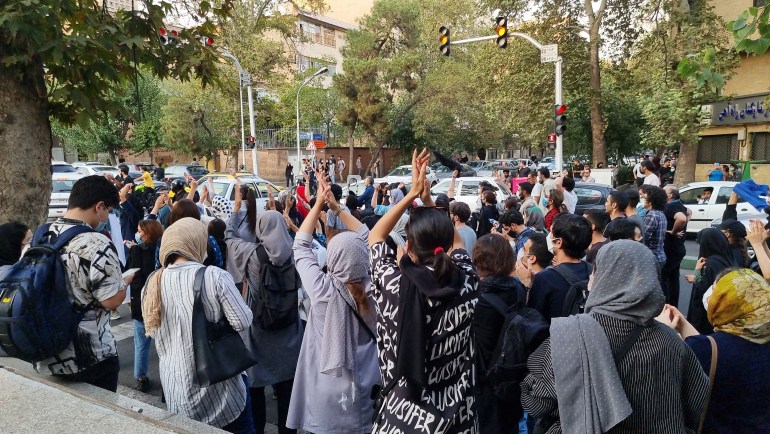
[MUSIC PLAYING]
Dorsa Jabbari: She’s originally from Saqqez in Kurdistan province, northwestern Iran. She was visiting Tehran with her family. Her family said that she was really looking forward to the visit. She was excited about being in the capital. But things certainly turned very, very bad, very quickly.
Halla Mohieddeen: On Tuesday, September 13, Mahsa was stopped by police in Iran, who said she was wearing an improper hijab.
Dorsa Jabbari: What really triggered a response was how quickly the officials put out their version of the story. They said that she was detained for allegedly not wearing the appropriate hijab, which is mandatory in the country. And then she was taken to a police station where they hold these so-called re-education classes that last about an hour, about the appropriate hijab in the country, what it looks like. And then they said that she had a heart attack while she was in that facility and she was transported to hospital and she was in a coma for three days before she died on Friday.
Halla Mohieddeen: Officials said Mahsa had pre-existing conditions, something her family has denied. And they say the blame lies with the police.
Dorsa Jabbari: We heard from her brother initially, because he was with her when she was arrested. The Gasht-e-Ershad, or the morality police, as they’re known, when they arrested her, her brother tried to prevent them from taking Mahsa. And he said that they dealt with him very violently and dragged her away. And they have these vans that they put women in and they transport them to this police station. And he said there were other women as well that were detained. So she wasn’t alone in that van. He says he then followed the van as is procedure. The family will then follow the women who are arrested and wait for them to be released. And he said he never saw her again until she was lying in her hospital bed in a coma.
[MUSIC PLAYING]
Halla Mohieddeen: Talk to me a little bit about the type of police, these morality police who arrested Amini. How pervasive are they?
Dorsa Jabbari: Well, you never really know what kind of a reaction, what kind of an interaction you’re going to have. I’ve heard some people who have been let go with a warning, and others that have been taken away and punished. It just depends who that person is that you come across.
Halla Mohieddeen: Iran has had a mandatory dress code in place since the 1979 revolution. Women are required to cover their hair and neck with a headscarf, and to wear a long coat that conceals their bodies. And the government uses the morality police to enforce this dress code.
[MUSIC PLAYING]
Halla Mohieddeen: The morality police are always around. We don’t know where they’re going to be. Every time we leave the house, it’s always in the back of our minds. Should I wear this head scarf? Should I pick something more conservative? You just don’t know what you’re going to encounter whenever you leave the house. So it really puts you in a mindset that you always have to think and worry about how you’re dressed and where you’re going. And it’s just, it’s exhausting and it’s draining and it’s an extra layer of stress that is added to women’s lives.
Halla Mohieddeen: Over the decades, there’s been a push and pull between many women – especially in big cities – and the government about what can be worn in public.
Dorsa Jabbari: What I deem to be appropriate may not be what they deem to be appropriate on any given day. And I think this is where the issue lies really that many of the women I’ve spoken to after Mahsa’s death, they were in tears, they were just crying. And I, and I was asking them, why are you crying? And they said, we are just so angry. We don’t know how else to express our feelings, and the issue isn’t just about the hijab. It’s about the fact that women want to be able to make that choice when they leave the house and not to live in this constant state of fear.
[MUSIC PLAYING]
Halla Mohieddeen: You were in Iran on Friday when the news of her death came out. Can you just describe what the immediate aftermath was like? I mean, what were you hearing from people?
Dorsa Jabbari: I think the reaction everybody had initially was complete and utter shock that this is happening in 2022. This particular case, I think, sparked so much outrage because it was so unexpected at a time when there’s so much pressure on the country, on the people. The economy is in shambles, the nuclear deal is up in the air. Everybody’s anxious. They don’t know what is going to happen in their day-to-day life. So this kind of pressure, on top of all that, is just too much for most. And the reaction we saw was so immediate. Like within hours, people were on the streets or trying to gather around the hospital where her body was still on Friday evening. But all the roads leading to the hospital were closed off by the officials. Nobody could get around. So …
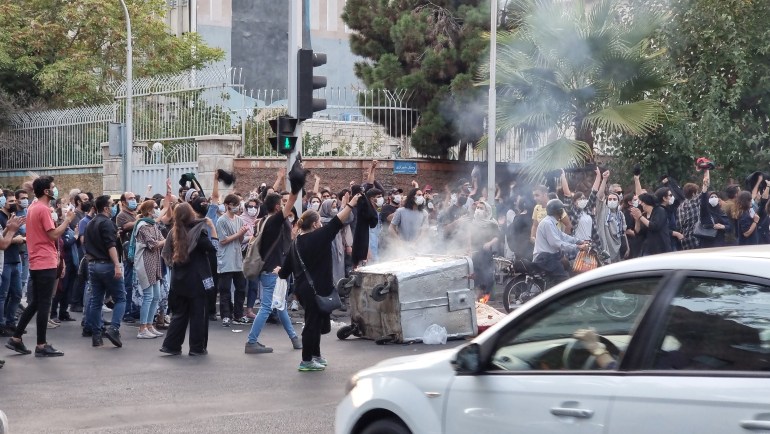
[CARS HONKING]
Dorsa Jabbari: …people were sitting in their cars in that area and honking their horns as a sign of protest.
[CARS HONKING]
Halla Mohieddeen: So you left Iran on Monday. What was the mood like as you were leaving the country?
Dorsa Jabbari: It was very tense. I mean, from Saturday after her funeral, I started seeing security forces patrolling the streets in certain parts of Tehran, a very small amount, because at that point, protests hadn’t started really outside of Kurdistan, her home region. But then the actual demonstrations began on Monday as I was leaving. I remember I was at the airport looking at social media.
[WOMEN CHEERING]
Dorsa Jabbari: and I could see a small number of people in different places in the country coming out.
[WOMEN CHEERING]
Dorsa Jabbari: There was certainly a sense that, you know, this story wasn’t going to go away. People were not satisfied with just the usual official lines.
Halla Mohieddeen: After the break, a look at the protests that have erupted since Mahsa’s death.
[CHEERING AND CHANTING FROM PROTESTS]
Halla Mohieddeen: We’ve not yet gotten official numbers from the protests in Iran. But there are reports saying dozens of people have been killed, and hundreds arrested.
[CHEERING AND CHANTING FROM PROTESTS]
[MUSIC PLAYING]
Halla Mohieddeen: To protest in Iran usually comes with great risk. And they don’t happen that frequently, especially after the demonstrations in 2009, over the country’s disputed elections.
Newsreel: Protesters have been clashing with police at rallies for the presidential candidate, Mir Hossein Mousavi.
Dorsa Jabbari: The biggest demonstrations we’ve seen, since 2009, was in 2017, and then in 2019, and that had to do with the country’s economy when they raised the prices of certain commodities like bread and petrol.
Newsreel: Anger and deadly violence in Iran escalate despite tough warnings from the country’s supreme leader.
Dorsa Jabbari: So in order to come out, there really has to be a great desire and a great feeling that this is the absolute last resort that people have, because they know how dangerous it is. So it’s not like people just come out and protest and go home. There is certainly a sense that things must be very, very bad And the fact that we’ve seen these now just attests to that sentiment.
Halla Mohieddeen: We heard from someone in Iran about these protests – both the ones happening now, and the ones a few years back. We’re keeping him anonymous at his request. And he told us that he thought the response to the protests in 2019 were harsher due to new rounds of sanctions imposed by the US.
Anonymous: When new sanctions were imposed on the Iranian regime and because of the lack of the control over the prices and economy and so many other factors and reasons, the regime became more brutal against its own people.
Halla Mohieddeen: He thinks the government of former US President Donald Trump expected Iranian society to explode, leading to a change in government.
Anonymous: But this is a very bloody sort of a policy for a foreign country to impose on another country.
Halla Mohieddeen: During those demonstrations in 2019, he reminds us, many people were killed. But now, a few years later, he’s seeing protesters again by his home near Tehran.
Anonymous: People outraged on the streets. No one got the right to tell you how to dress up, how to walk on the street, what to eat, what to drink, how to think. What kind of treatment is that to the people? When a regime doesn’t respect people, the regime will see the consequences sooner or later.
Halla Mohieddeen: Here’s Dorsa again, explaining why she thinks these protests have taken off.
Dorsa Jabbari: I think the women in the country are not as afraid as they have been in the past. They feel like they have gone through it all. And, this story is just one too many blows to their way of life. The women I spoke to, I said, why do you think the story is gaining more and more momentum, both inside and outside the country. And she said to me, this is where we draw the line as women. This cannot be tolerated.
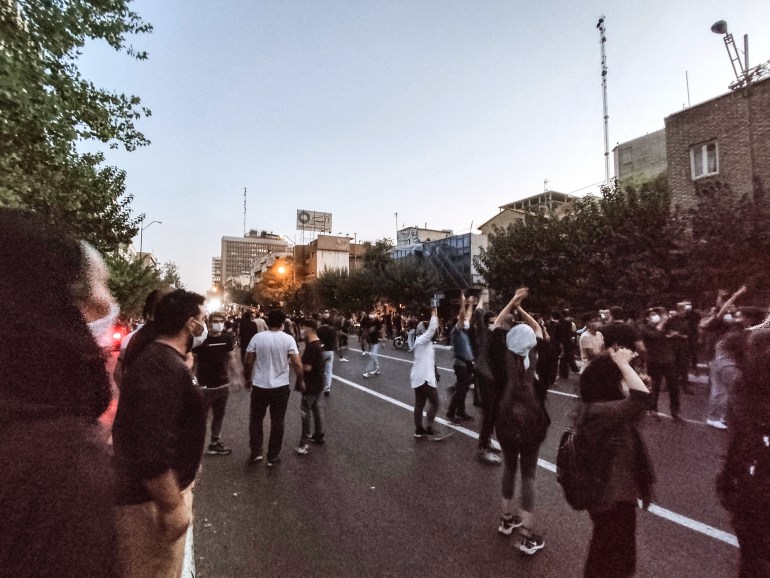
[MUSIC PLAYING]
Dorsa Jabbari: Some of the chants we’ve been hearing …
[PROTEST CHANTS]
Dorsa Jabbari: … are “women are oppressed from Kurdistan to Tehran”.
[PROTEST CHANTS]
Dorsa Jabbari: “Woman, life, freedom.
[PROTEST CHANTS]
Dorsa Jabbari: “Justice, liberty, no to forced hijab.”
Halla Mohieddeen: Talk to us about some of the things that women are doing. Is there anything in particular that stuck with you?
Dorsa Jabbari: There’s one video of a woman sitting down in a park area with a few riot policemen around her without a head scarf, with a mask on, she has a white mask on and she’s just sitting there.
[MUSIC PLAYING]
Dorsa Jabbari: She’s not saying anything, she’s not doing anything, but she’s not wearing a headscarf. And the security officers are not doing anything, either. And this is something that really has struck a lot of people as unbelievable.
Halla Mohieddeen: And in the days since I spoke with Dorsa, more videos like this have come out. Some show women dancing in the street with their hair loose, surrounded by protesters. Others show them simply out and about, living their lives, but ignoring the dress code. There’s another type of video making its way around, too.
Dorsa Jabbari: I think the general image that we’re seeing is the women cutting their hair basically saying if it’s such an issue for the officials, they would just not have any hair.
Halla Mohieddeen: Wow.
Dorsa Jabbari: They would rather cut it all off.
Halla Mohieddeen: Some women are posting videos of themselves …
[HAIR CUTTING]
Halla Mohieddeen: … chopping their hair off alone at their homes. And other videos have been shared thousands of times of women cutting their hair in public.
[MUSIC PLAYING]
[WOMAN CUTTING HAIR]
Halla Mohieddeen: In one, a woman sits on a utility box in a crowd of protesters, and takes scissors to her ponytail.
Halla Mohieddeen: Over the weekend, another emerged.
[WOMAN CUTTING HAIR AT FUNERAL]
Halla Mohieddeen: It’s said to be taken from the funeral of one man, who was reportedly killed while protesting. And his sister cuts her hair while weeping over his grave.
Halla Mohieddeen: Are you also seeing solidarity from men about what women are having to endure in Iran?
Dorsa Jabbari: Yes, absolutely. There’s a lot of men and, at the protests, the men are with the women and there also have been very well-known figures in Iran, men, including. one of the most famous actors inside the country who’s also a producer and he’s very well connected. He makes a lot of shows and series for state TV. Mehran Modiri is his name. He put out a statement …
[MEHRAN MODIIRI SPEAKING]
Dorsa Jabbari: …on his Instagram account, saying. ‘I do not want any of my work that has been commissioned sold whatever stage it’s in in collaboration with state TV, they do not have permission to run any of it until they respond to the people’s demands.’
Halla Mohieddeen: He’s not the only one; others associated with the government, like former president Mohammad Khatami, have come out criticising the morality police.
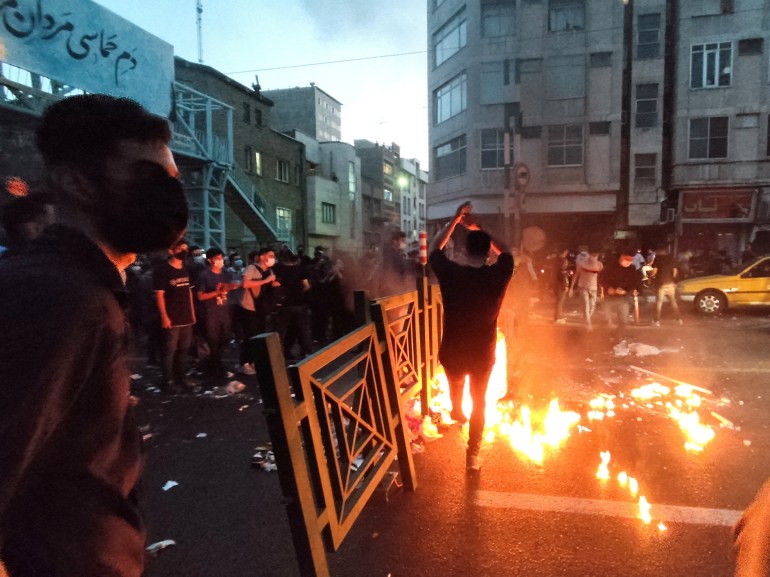
[MUSIC PLAYING]
Halla Mohieddeen: But when I spoke to Dorsa last week, hearing anything was becoming difficult as internet access was becoming harder and harder to come by in Iran.
Dorsa Jabbari: Over the past few days, internet connectivity has been interrupted in the country and people are not able to reach out as easily as they have been.
Halla Mohieddeen: Well, that’s, that’s significant, isn’t it? Because a lot of any mobilising is done through social media apps and so on. And if the internet is being, is being restricted, I mean that’s surely a sign isn’t it, that the authorities are very worried?
Dorsa Jabbari: It’s a sign that I think the worst is yet to come. Last time we saw anything like this was in 2019 when there were those protests about the fuel prices. I had no connectivity to anything in the outside world and it was the strangest feeling. And it was during that time that we heard of all the fatalities that happened. The government said that they were confronting what they call terrorists, or, elements that are implanted into these demonstrations from opposition groups outside of Iran.
Halla Mohieddeen: Dorsa says she’s seen the same conversations this time around, too.
[MUSIC PLAYING]
[PROTEST SOUNDS]
Halla Mohieddeen: There were pro-government rallies held on Friday and Sunday, in support of the security forces.
[PROTEST SOUNDS]
Dorsa Jabbari: But the connectivity of the internet, the restrictions is certainly, it’s troubling. The officials have said they don’t want people inside the country to be influenced by those outside. They don’t want the people outside of Iran who are supporting a regime change to fuel this movement towards their own goal. And the other issue is they don’t want biased footage to get out, basically. So this is their way of controlling it.
Halla Mohieddeen: Well, we have managed to see some videos coming out on social media, showing some of the protests in Iran. And I, I have to stress the reason that we’re able to talk to you is because you’re not inside the country. So we’re able to get that internet connection with you so we can have this conversation, but of the videos that have managed to get out, how widespread do you think these protests are and what can we learn from the videos that have made it out of the country?
Dorsa Jabbari: I think the first thing that is of note is, these protests are across the country. They’re not isolated to Mahsa’s province or the capital, which is usually the case. They are across a number of cities and towns. That is something we haven’t seen before, even in the south, in the island of Kish, we’ve seen footage of protests, which is somewhere we don’t usually see protests. The other thing is the dynamic between the protesters and the security forces is interesting.
Dorsa Jabbari: Because, if you watch in a number of videos, even though they are standing their ground, the people are actually attacking some of those security forces in response or in retaliation, or however you want to interpret it.
Halla Mohieddeen: That’s unusual, no?
Dorsa Jabbari: It is very unusual, yes. I haven’t seen it, certainly, before. Usually there’s a lot of fear and people running away from them, but now they’re standing firm and they’re confronting them. There’s a number of incidents we’ve seen where people actually take someone from the security forces who was going to attack them and they either beat him or take him away or disrupt what he was about to do, basically. And this is also being used by the government as an example of the fact that people are attacking the security forces.
Halla Mohieddeen: Iranian President Ebrahim Raisi said Mahsa’s death should be investigated. He’s also said this, about the demonstrations:
Ebrahim Raisi: They want to ride a wave and create riots and disturbances. They think with such moves, they can stop the nation. We have announced many times that if anyone has a fair comment, we will listen to it. But anarchy, disturbing national security, the security of people, no one will succumb to this.
Halla Mohieddeen: Is this just about head scarfs, or the morality police or, or is there something a bit deeper there that people are rising up against?
Dorsa Jabbari: It’s about basic rights for women. Given Iran’s history with, hijab, it’s understandable. I mean, it’s always extremes with Iran. This is one of the main issues. Before the revolution in 1979, the former shah of Iran banned women from covering up completely in normal, ordinary places. It was the other extreme to what we have now.
Halla Mohieddeen: And do you get the sense that people just want something a bit more moderate? I mean, it just strikes me as strange that the country is going through this enormously, enormously difficult time. There’s the external factors with the ongoing sanctions. You’ve got the threat of climate change looming overhead. And the thing that the morality police are apparently focusing on is whether someone’s hair is showing. I mean, do you get the sense that people are just at some kind of breaking point with the whole thing?
Dorsa Jabbari: I think like you said, there’s much bigger issues. There’s much bigger problems and things like this should not happen in 2022. It should not happen now. Period.
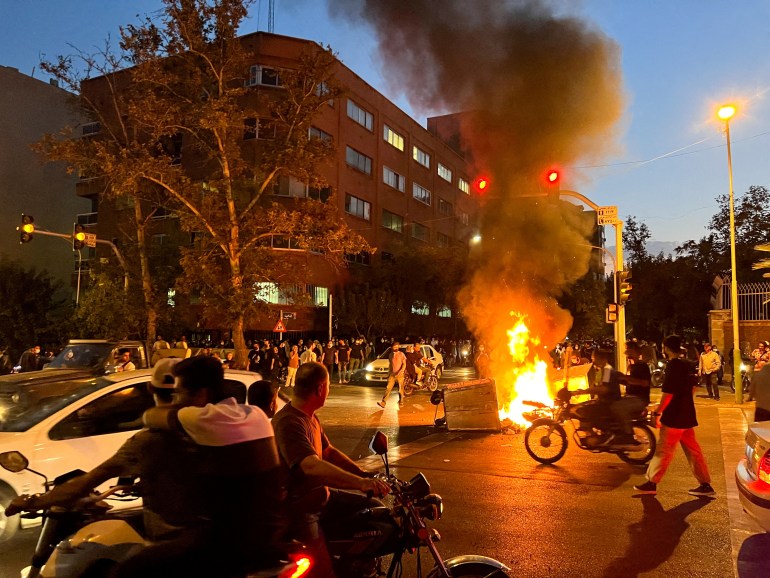
[MUSIC PLAYING]
Dorsa Jabbari: I mean, it’s not just Iran, we know, but this particular case has brought to light the issues at the core of this. The problem of forcing women to behave and look a certain way really is troubling in our time. Women should be able, regardless of where they are, what their background is, if they want to wear full head to toe hijab, they should be able to do so. And if they don’t, they should also be able to do so. But they should have the choice. And the women in Iran are saying we don’t have that choice.
Halla Mohieddeen: And that’s The Take. This episode was produced by Negin Owliaei with Ruby Zaman, Amy Walters, Chloe K. Li, Ashish Malhotra, Alexandra Locke, and me, Halla Mohieddeen. Alex Roldan is our sound designer. Aya Elmileik and Adam Abou-Gad are the Take’s engagement producers. And Ney Alvarez is head of audio. We’ll be back on Friday.
Episode credits:
This episode was produced by Negin Owliaei and Ruby Zaman with our host, Halla Mohieddeen. Ruby Zaman fact-checked this episode. Our production team includes Chloe K. Li, Alexandra Locke, Ashish Malhotra, Negin Owliaei, Amy Walters, and Ruby Zaman. Our sound designer is Alex Roldan. Our engagement producers are Aya Elmileik and Adam Abou-Gad. Ney Alvarez is Al Jazeera’s head of audio.